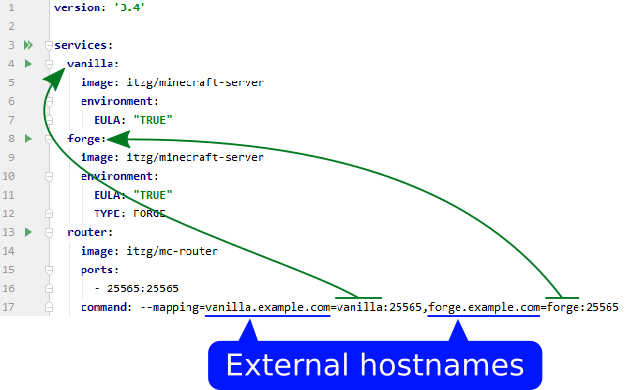Routes Minecraft client connections to backend servers based upon the requested server address.
Usage
-api-binding host:port
The host:port bound for servicing API requests (env API_BINDING)
-connection-rate-limit int
Max number of connections to allow per second (env CONNECTION_RATE_LIMIT) (default 1)
-cpu-profile string
Enables CPU profiling and writes to given path (env CPU_PROFILE)
-debug
Enable debug logs (env DEBUG)
-in-kube-cluster
Use in-cluster kubernetes config (env IN_KUBE_CLUSTER)
-kube-config string
The path to a kubernetes configuration file (env KUBE_CONFIG)
-mapping string
Comma-separated mappings of externalHostname=host:port (env MAPPING)
-metrics-backend string
Backend to use for metrics exposure/publishing: discard,expvar,influxdb (env METRICS_BACKEND) (default "discard")
-metrics-backend-config-influxdb-addr string
(env METRICS_BACKEND_CONFIG_INFLUXDB_ADDR)
-metrics-backend-config-influxdb-database string
(env METRICS_BACKEND_CONFIG_INFLUXDB_DATABASE)
-metrics-backend-config-influxdb-interval duration
(env METRICS_BACKEND_CONFIG_INFLUXDB_INTERVAL) (default 1m0s)
-metrics-backend-config-influxdb-password string
(env METRICS_BACKEND_CONFIG_INFLUXDB_PASSWORD)
-metrics-backend-config-influxdb-retention-policy string
(env METRICS_BACKEND_CONFIG_INFLUXDB_RETENTION_POLICY)
-metrics-backend-config-influxdb-tags value
any extra tags to be included with all reported metrics (env METRICS_BACKEND_CONFIG_INFLUXDB_TAGS)
-metrics-backend-config-influxdb-username string
(env METRICS_BACKEND_CONFIG_INFLUXDB_USERNAME)
-port port
The port bound to listen for Minecraft client connections (env PORT) (default 25565)
-version
Output version and exit (env VERSION)
REST API
-
GET /routes(withAccept: application/json)Retrieves the currently configured routes
-
POST /routes(withContent-Type: application/json)Registers a route given a JSON body structured like:
{ "serverAddress": "CLIENT REQUESTED SERVER ADDRESS", "backend": "HOST:PORT" } -
POST /defaultRoute(withContent-Type: application/json)Registers a default route to the given backend. JSON body is structured as:
{ "backend": "HOST:PORT" } -
DELETE /routes/{serverAddress}Deletes an existing route for the given
serverAddress
Docker Multi-Architecture Image
The multi-architecture image published at Docker Hub supports amd64, arm64, and arm32v6 (i.e. RaspberryPi).
Docker Compose Usage
The following diagram shows how the example docker-compose.yml
configures two Minecraft server services named vanilla and forge, which also become the internal
network aliases. Notice those services don't need their ports exposed since the internal
networking allows for the inter-container access.
The router service is only one of the services that needs to exposed on the external
network. The --mapping declares how the hostname users will enter into their Minecraft client
will map to the internal services.
To test out this example, I added these two entries to my "hosts" file:
127.0.0.1 vanilla.example.com
127.0.0.1 forge.example.com
Kubernetes Usage
Using kubernetes service auto-discovery
When running mc-router as a kubernetes pod and you pass the --in-kube-cluster command-line argument, then
it will automatically watch for any services annotated with
mc-router.itzg.me/externalServerName: The value of the annotation will be registered as the external hostname Minecraft clients would used to connect to the routed service. The service's clusterIP and target port are used as the routed backend. You can use more hostnames by splitting them with comma.mc-router.itzg.me/defaultServer: The service's clusterIP and target port are used as the default if no otherexternalServiceNameannotations applies.
For example, start mc-router's container spec with
image: itzg/mc-router
name: mc-router
args: ["--in-kube-cluster"]and configure the backend minecraft server's service with the annotation:
apiVersion: v1
kind: Service
metadata:
name: mc-forge
annotations:
"mc-router.itzg.me/externalServerName": "external.host.name"you can use multiple host names:
apiVersion: v1
kind: Service
metadata:
name: mc-forge
annotations:
"mc-router.itzg.me/externalServerName": "external.host.name,other.host.name"Example kubernetes deployment
- Declares an
mc-routerservice that exposes a node port 25565 - Declares a service account with access to watch and list services
- Declares
--in-kube-clusterin themc-routercontainer arguments - Two "backend" Minecraft servers are declared each with an
"mc-router.itzg.me/externalServerName"annotation that declares their external server name(s)
kubectl apply -f https://raw.githubusercontent.com/itzg/mc-router/master/docs/k8s-example-auto.yamlNotes
- This deployment assumes two persistent volume claims:
mc-stableandmc-snapshot - I extended the allowed node port range by adding
--service-node-port-range=25000-32767to/etc/kubernetes/manifests/kube-apiserver.yaml
Development
Building locally with Docker
docker build -t mc-router .Skaffold
For "in-cluster development" it's convenient to use https://skaffold.dev. Any changes to Go source code will trigger a go build, new container image pushed to registry with a new tag, and refresh in Kubernetes with the image tag used in the deployment transparently updated to the new tag and thus new pod created pulling new images:
skaffold dev
When using Google Cloud (GCP), first create a Docker Artifact Registry,
then add the Artifact Registry Reader Role to the Compute Engine default service account of your GKE clusterService Account_ (to avoid error like "container mc-router is waiting to start: ...-docker.pkg.dev/... can't be pulled"),
then use e.g. gcloud auth configure-docker europe-docker.pkg.dev or equivalent one time (to create a ~/.docker/config.json),
and then use e.g. --default-repo=europe-docker.pkg.dev/YOUR-PROJECT/YOUR-ARTIFACT-REGISTRY option for skaffold dev.
Performing snapshot release with Docker
docker run -it --rm \
-v ${PWD}:/build -w /build \
-v /var/run/docker.sock:/var/run/docker.sock \
goreleaser/goreleaser \
release --snapshot --rm-dist





